Little hedges
There is nothing like a neat little hedge to bring a beautiful a garden into sharp focus.
And there is nothing like classic English box to do the job. Or is there? The reliable little box hedge, aka Buxus, is a time-honoured favourite. It’s vast popularity dates back centuries and still today, for those who love the neatness and order of a well-defined border, Buxus is hard to beat. It responds brilliantly to trimming with a uniform flush of new growth, like a coat of fresh green paint. There are various species to choose from, all with small evergreen leaves, and dense growth of desirable darkest green. Box is easy to grow and it doesn’t grow too fast which means it only needs trimming a couple of times a year and it has a long life. But this stellar reputation has been dealt a sad blow ever since box blight disease started making its presence felt.
But the good news is, Buxus isn’t the only plant born for trimming. If the blight has struck at your place, or you simply want something different, there are some very attractive alternatives.
Designer’s Dozen
Top low hedges, 25-90cm tall
| 1 | Buxus (English Box) The most commonly grown species is Buxus sempervirens. Also popular, Buxus microphylla var. japonica is a quick grower with shiny leaves. Buxus ‘Green Gem’ is a modern hybrid that is showing signs of being less prone to blight. |
| 2 | Corokia New Zealand native Corokias rate highly as hedge plants, with tiny leaves in colours ranging from olive green through greys and silvers to chocolate brown, and dense twiggy growth. Corokia x virgata 'Geenty's Ghost' can be kept as low as 25cm, with beautiful dense growth. 'Geenty's Green' and 'Frosted Chocolate' suit a height of around 90cm. Corokias must have well drained soil. |
| 3 | Myrtus ugni A very compact hedge with small leathery leaves, red new growth, and sweet edible berries in early autumn. Also known as NZ cranberry, it is actually a native of Chile. |
| 4 | Ligustrum rotundifolium This dark green, curly-leafed shrub is slow growing and very frost hardy. As a hedge of around 80cm tall, it makes an excellent alternative to Buxus. |
| 5 | Lonicera (Box honeysuckle) Fast growing box lookalike, Lonicera nitida and its golden form, L. nitida ‘Aurea’ give a very smooth finish when trimmed, but fast growth means lots of trimming to maintain shape and tight growth. |
| 6 | Teucrium Fruticans Charming in soft silvery olive and very popular as fast formal hedging, this hedge requires frequent trimming. |
| 7 | Coprosma Rich mahogany coloured Coprosma ‘Cappuccino’ is regarded by experts as one of the best for little hedges, with tight growth, and tiny leaves that hold well, all the way to the base. Coprosma ‘Middlemore’ is bright shiny green, ideal as a medium size hedge. For a really bright colourful hedge try Coprosma ‘Tequila Sunrise’ or new Coprosma ‘Inferno’. Coprosma hedges are quick growing and need regular trimming. New growth is sensitive to frost. |
| 8 | Myrtus x ralphii ‘Red Dragon’ Small crinkly leaves emerge bright red and turn darker as they age. The vibrant tones of this excellent NZ native intensify as the weather cools. A red hedge makes a magnificent accent in a mainly green garden. |
| 9 | Berberis (barberry) Don’t rule out a deciduous hedge. Berberis thunbergia varieties make stunning little hedges with vibrant tones of red, purple, orange or yellow. In mid-winter, the textured framework of leafless branches has a character all of its own. There are spines, but these can be very useful for traffic control. |
| 10 | Podocarpus totara ‘Matapouri Blue’ This blue-green totara makes a stunning hedge, whether you want to keep it below a metre grow it tall for privacy. |
| 11 | Ilex x meserveae ‘Blue Angel’ This holly variety has very dark blue/black foliage and deep red winter berries. It is slow growing, ultimately to two metres tall, but easily kept below a metre. |
| 12 | Feijoa Feijoas make wonderful hardy hedges, with flowers and fruit as extras, but until now they have been mainly for taller hedges. Just released, Feijoa ‘Bambino’ presents an exciting new option for a low wall of small grey-green leaves, spring flowers and dainty autumn fruit. Prune early in spring to ensure growth for autumn fruit. |
Hedge basics
- Autumn is an ideal time to plant new hedges.
- Purchase vigorous young plants of an even grade. For instant results, ready-made hedging is available by the linear metre. Ask about this at your garden centre or visit www.tvn.co.nz.
- In mid-late spring, once the newly planted hedge has had its first flush of new growth, cut it back by a half. Early pruning is important to encourage thick, even growth.
- String lines will help you achieve a straight, even trim.
- Most hedges require clipping twice annually - in spring and again in late summer. Fast growing hedges may need up to 4 trims per year.
- Beware of pruning too heavily later in autumn, as the resulting fresh growth will be susceptible to frost damage.
- Shaping hedges with slightly sloping sides so that they are slightly narrower at the top encourages leaf growth all the way to the base, as this means more light reaches lower branches.
- Give your hedges a good soaking during dry periods, but avoid overhead sprinklers.
- Feed hedges in spring with controlled release fertiliser.
Buxus blight
This fungal disease causes areas of unsightly dieback, eventually killing the plant. It spreads via spores released in spring and enters the stems via pruning cuts or stress cracks. Removing infected parts and regular spraying with copper, especially after pruning, can slow the spread. Improving air-flow around box hedges and keeping them free of debris may also help.

30-Mar-2015
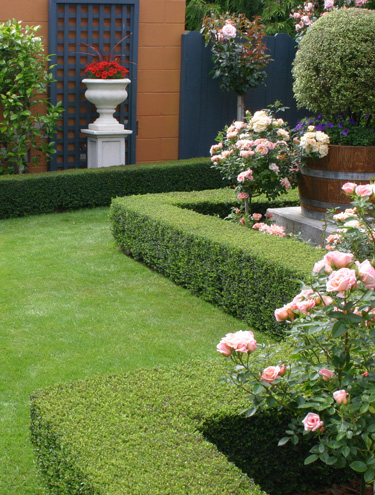
Lonicera nitida
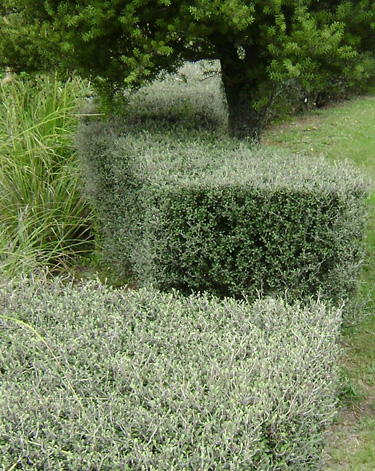
Corokia 'Silver Ghost'
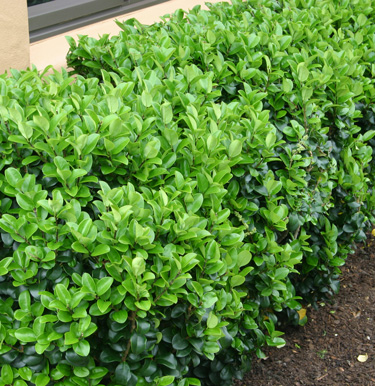
Ligustrum rotundifolium
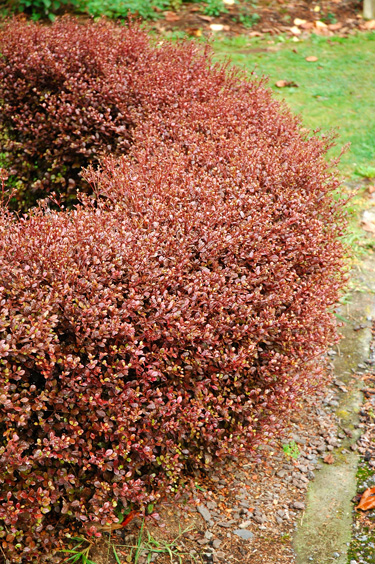
Myrtus 'Red Dragon'
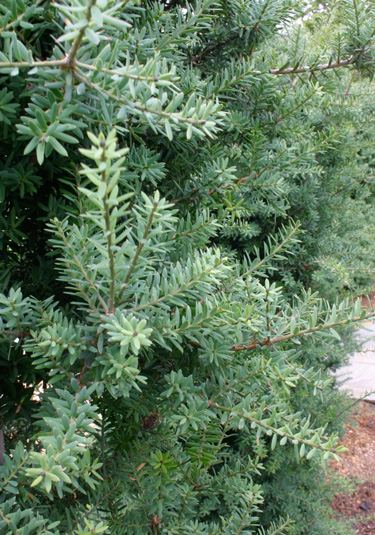
Totara 'Matapouri Blue'

